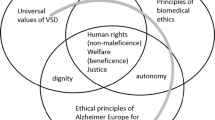Abstract
Implicit in the value sensitive design (VSD) approach is a concern for understanding, and where possible, disrupting problematic power relationships. Yet an awareness of the issues and ethics of power relations is a pre-requisite for such a concern to bear fruit. This article provides some insight into the issues, and through a case study of technology design to support care arrangements for age-related cognitive decline, illustrates how finding a satisfactory resolution can be particularly troublesome.
Similar content being viewed by others
References
Agarwal, S. D. (2015). The process of networked civic innovation: Examining the role of values, resources, and power in community-based technology projects. Seattle: University of Washington.
Bjerknes, G., Ehn, P., & Kyng, M. (1987). Computers and democracy: A Scandinavian challenge. Aldershot, UK: Avebury.
Bødker, S., Ehn, P., Sjögren, D., & Sundblad, Y. (2000). Co-operative design—Perspectives on 20 years with ‘the Scandinavian IT design model. In Proceedings of NordiCHI 2000, Stockholm.
Brey, P. (2007). The technological construction of social power. Social Epistemology, 22(1), 71–95.
Burmeister, O. K. (2010). Websites for seniors: Cognitive accessibility. International Journal of Emerging Technologies and Society, 8(2), 99–113.
Burmeister, O. K. (2012). What seniors value about online community. Journal of Community Informatics, 8(1).
Burmeister, O. K. (2016). The development of assistive dementia technology that accounts for the values of those affected by its use. Ethics and Information Technology, 18(3), 185–198. https://doi.org/10.1007/s10676-016-9404-2.
Burmeister, O. K., Weckert, J., & Williamson, K. (2011). Seniors extend understanding of what constitutes universal values. Journal of Information, Communication & Ethics in Society, 9(4), 238–252. https://doi.org/10.1108/14779961111191048.
Fitzpatrick, G., Huldtgren, A., Malmborg, L., Harley, D., & Ijsselsteijn, W. (2015). Design for agency, adaptivity and reciprocity: Reimagining AAL and telecare agendas. In V. Wulf, K. Schmidt & D. Randall (Eds.), Designing socially embedded technologies in the real-world (pp. 305–338). London: Springer London.
Friedman, B., Hendry, D. G., & Borning, A. (2017). A survey of value sensitive design methods. Foundations and Trends® in Human–Computer Interaction, 11(2), 63–125. https://doi.org/10.1561/1100000015.
Heusinger, M. J. (2013). Challenges of critical and emancipatory design science research: the design of ‘Possible Worlds’ as response. In 15th International conference on enterprise information systems, Angers, 04–07 July 2013 (pp. 233–239). Institute for Systems, Technologies of Information, Control, and Communication (INSTICC).
Kreps, D. (Ed.). (2015). Gramsci and Foucault: A Reassessment. Farnham: Ashgate Publishing.
Kreps, D., Burmeister, O. K., & Blaynee, J. (2016). Skeuomorphic reassurance: Personhood and dementia. In D. Kreps, G. Fletcher, & M. Griffiths (Eds.), Technology and intimacy: Choice or coercion: 12th IFIP TC 9 international conference on human choice and computers, HCC12 2016, Salford, UK, September 7–9, 2016, Proceedings (pp. 61–71). Cham: Springer.
Schikhof, Y., Mulder, I., & Choenni, S. (2010). Who will watch (over) me? Humane monitoring in dementia care. International Journal of Human-Computer Studies, 68(6), 410–422. https://doi.org/10.1016/j.ijhcs.2010.02.002.
Sharkey, A. J. C. (2014). Robots and human dignity: The effects of robot care on the dignity of older people. Ethics and Information Technology, 16(1), 53–75. https://doi.org/10.1007/s10676-014-9338-5.
Teipel, S., Babiloni, C., Hoey, J., Kaye, J., Kirste, T., & Burmeister, O. K. (2016). Information and communication technology solutions for outdoor navigation in dementia. Alzheimer’s & Dementia: The Journal of the Alzheimer’s Association, 12(6), 695–707. https://doi.org/10.1016/j.jalz.2015.11.003.
Winner, L. (1986). The whale and the reactor: A search for limits in an age of high technology. Chicago: The University of Chicago Press.
Author information
Authors and Affiliations
Corresponding author
Rights and permissions
About this article
Cite this article
Burmeister, O.K., Kreps, D. Power influences upon technology design for age-related cognitive decline using the VSD framework. Ethics Inf Technol 23, 95–98 (2021). https://doi.org/10.1007/s10676-018-9460-x
Published:
Issue Date:
DOI: https://doi.org/10.1007/s10676-018-9460-x




